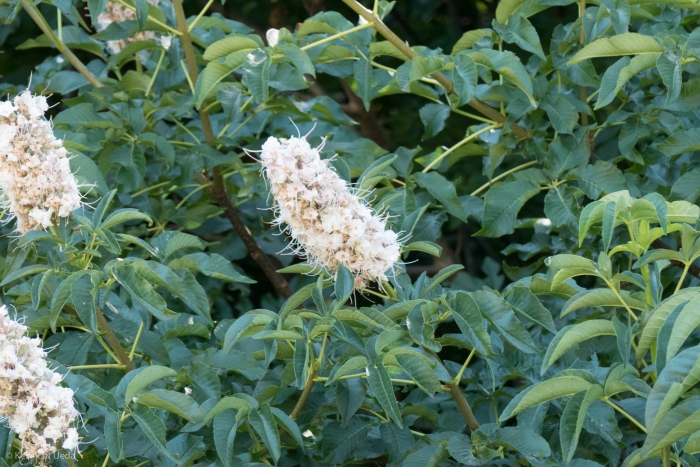California Buckeye
(Aesculus californica)
California Buckeye (Aesculus californica)
/
/

Ken-ichi Ueda
CC BY 4.0
Image By:
Ken-ichi Ueda
Recorded By:
Copyright:
CC BY 4.0
Copyright Notice:
Photo by: Ken-ichi Ueda | License Type: CC BY 4.0 | License URL: http://creativecommons.org/licenses/by/4.0/ | Rights Holder: Ken-ichi Ueda | Publisher: iNaturalist | Date Created: 2017-05-27T16:03:19-07:00 |































































































































Estimated Native Range
Summary
Aesculus californica, commonly known as California Buckeye, is a deciduous tree or large shrub native to the coastal ranges and foothills of California, extending into the southernmost part of Oregon. It is typically found in mixed evergreen forests, oak woodlands, and chaparral environments. The California Buckeye grows to a height of 13-35 feet (4-11 meters) and a width of 15-30 feet (4.5-9 meters), with a multi-trunked habit and a rounded canopy. Its leaves are palmately compound, and it produces showy, erect panicles of pink and white flowers in late spring to early summer, followed by large, pear-shaped fruits with a leathery husk.
The California Buckeye is valued for its drought tolerance once established, making it suitable for xeriscaping. Its striking flowers and interesting seed capsules add ornamental value, and it can serve as a focal point in a native garden or naturalized landscape. It is adaptable to a range of soil types, provided they have good drainage, and it can tolerate both full sun and part shade. While it is relatively low maintenance, it is important to note that all parts of the plant are toxic if ingested. Additionally, the tree may go dormant and lose its leaves during periods of drought to conserve water.CC BY-SA 4.0
The California Buckeye is valued for its drought tolerance once established, making it suitable for xeriscaping. Its striking flowers and interesting seed capsules add ornamental value, and it can serve as a focal point in a native garden or naturalized landscape. It is adaptable to a range of soil types, provided they have good drainage, and it can tolerate both full sun and part shade. While it is relatively low maintenance, it is important to note that all parts of the plant are toxic if ingested. Additionally, the tree may go dormant and lose its leaves during periods of drought to conserve water.CC BY-SA 4.0
Plant Description
- Plant Type: Tree, Shrub
- Height: 13-35 feet
- Width: 15-30 feet
- Growth Rate: Moderate
- Flower Color: White
- Flowering Season: Spring
- Leaf Retention: Deciduous
Growth Requirements
- Sun: Full Sun, Part Shade
- Water: Medium
- Drainage: Fast, Medium
Common Uses
Bee Garden, Bird Garden, Butterfly Garden, Deer Resistant, Drought Tolerant, Erosion Control, Fire Resistant, Fragrant, Hummingbird Garden, Rabbit Resistant
Natural Habitat
Native to coastal ranges and foothills of California, mixed evergreen forests, oak woodlands, and chaparral environments
Other Names
Common Names: California Horse Chestnut
Scientific Names: , Aesculus californica, Hippocastanum californicum, Calothyrsus californica, Pavia californica, Pawia californica,
GBIF Accepted Name: Aesculus californica (Spach) Nutt.